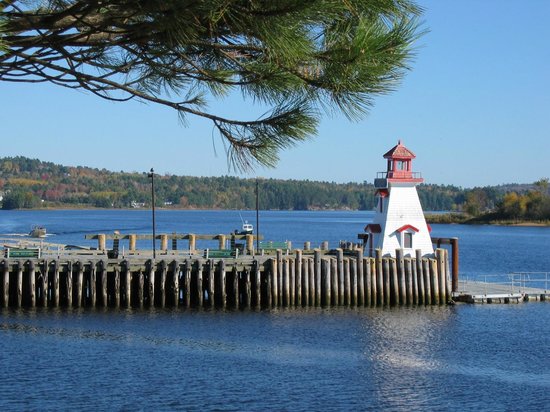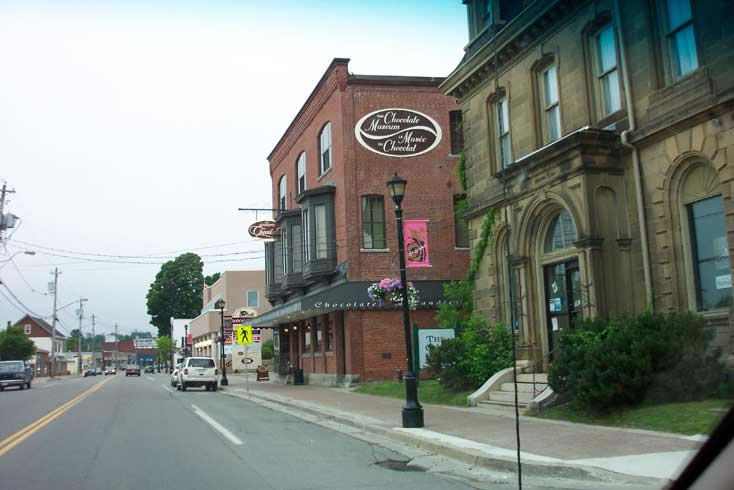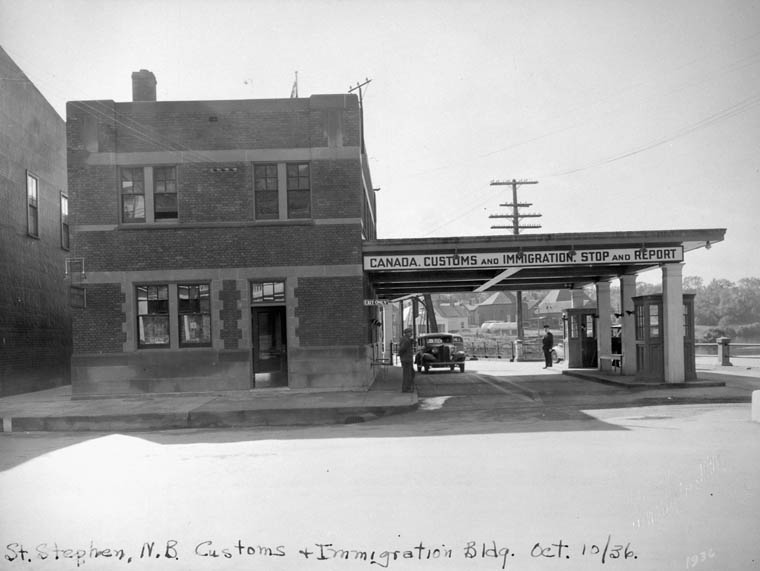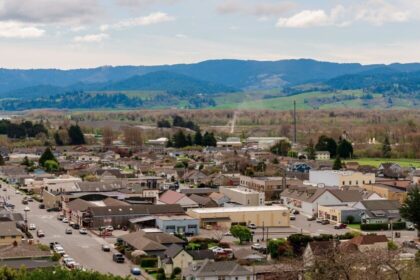St. Stephen (2016 population: 4,415) is a Canadian town in Charlotte County, New Brunswick, situated on the east bank of the St. Croix River around the intersection of New Brunswick Route 170 and the southern terminus of New Brunswick Route 3. The St. Croix River marks a section of the Canada–United States border, forming a natural border between Calais, Maine and St. Stephen. U.S. Route 1 parallels the St. Croix river for a few miles, and is accessed from St. Stephen by three cross-border bridges. Take a look below for 30 fun and amazing facts about St. Stephen, New Brunswick, Canada.
1. The Passamaquoddy people were the first to make their home along the St. Croix River. They dispersed and hunted inland in the winter; in the summer, they gathered more closely together on the coast and islands, and primarily harvested seafood, including porpoise.
2. In 1604, French explorer Samuel de Champlain and his men spent a winter here. The Passamaquoddy were forced off their original lands repeatedly by European settlers since that time.
3. During Queen Anne’s War, in response to the French Raid on Deerfield, New Englander Major Benjamin Church raided the Acadian villages of Castine, Maine (then known as Penobscot). From the Raid on Castine, Maine, Church learned that Michel Chartier, who was granted the land of present-day St. Stephen, was building a fort at Passamaquoddy Bay.
4. Church and his men arrived at the Passamaquoddy Bay on board the Province Galley, Gosport and Fearly and several other vessels.
5. Church travelled up the St. Croix River to St. Stephen and, on June 7, 1704, took Chartier by surprise and his family fled into the woods.
6. On June 13, Church reported they were destroying the crops of the Acadians and the Acadians and Natives fired upon Church’s troops and a three-hour exchange ensued. Church killed and imprisoned Acadians and Natives, with the total number being 35. One of Church’s men was wounded. They pillaged and plundered the community.

7. After the Raid on St. Stephen, Church moved on to raid other Acadian villages in the Raid on Grand Pré, the Raid on Piziquid, and the Raid on Chignecto.
8. St. Stephen was officially incorporated as a town in 1871.
9. Immediately prior to Confederation, the Legislature of New Brunswick passed a bill that incorporated the Houlton Branch Railway Company (HBRC) with the aim to build a railway between Debec, New Brunswick and Houlton, Maine (thus to complete a portion of the St. Andrews and Quebec Railway).
10. In 1870, the Legislature of New Brunswick passed an Act, authorising the County of Charlotte to issue debentures to pay a bonus of $15,000 to the HBRC, to encourage it to complete the railway. The debenture could only be issued if authorised by a public meeting of the ratepayers of St. Stephen, who would assume the obligation of paying for the interest and principal of the debenture.
11. A majority of the ratepayers of St. Stephen duly passed the necessary vote and the County issued the debenture. Some residents of St. Stephen who opposed the measure challenged the tax assessment in the Supreme Court of New Brunswick, arguing that the provincial Legislature lacked the constitutional authority to authorise a tax to support the building of an international railway, as that would intrude on the exclusive legislative authority of the Parliament of Canada.
12. In 1873, the Supreme Court of New Brunswick ruled that the provincial taxation statute was unconstitutional, because it intruded on federal jurisdiction over inter-jurisdictional railways.

13. The supporters of the railway measure appealed the case to the Judicial Committee of the Privy Council, at that time the court of last resort for Canada within the British Empire. The Judicial Committee, in the case of Dow v Black, allowed the appeal and held that the taxation statute was within provincial authority.
14. In 1877, St. Stephen’s business district was almost destroyed by fire when eighty buildings and 13 wharves burned.
15. In the 1970s, the municipalities of St. Stephen and Milltown joined together to become what is now simply known as St. Stephen. For a short time, the town was called St. Stephen-Milltown, but the new name not having caught on, reverted to simply the Town of St. Stephen. But for official use is called the Town of St.Stephen-Milltown as written agreement stated at amalgamation in 1973.
16. Every August since 1985, the town plays host to the week-long Chocolate Fest, celebrating their rich and delicious heritage. That spotlight on the wonder of chocolate resulted in the opening of The Chocolate Museum in 1999 and its expansion in 2009. In 2000, St. Stephen was given the title of “Canada’s Chocolate Town.” The festival mascots are the Great Chocolate Mousse and Tiffany.
17. The December 2010 flood upstream on a tributary to Dennis Stream caused hardship to the businesses that were located on or near King Street. Shoppers Drug Mart, the Winsome Inn, Sobey’s, Stationery Plus and the Irving Circle K gas station and convenience store, The Bargain Shop, Dollar Store, and the NB Liquor Store, were all affected by the 13 December rainstorm, some more than others.
18. The flood caused many layoffs, and Sobey’s eventually closed down. The problem was due to the replacement of a trestle bridge in Dennis Stream with culvert pipes.

19. The climate is temperate but greatly affected by the size of the Bay of Fundy. The bay is a cool body of water which acts as an air conditioner in the summer and diverts major snow storms in the winter. The bay never freezes.
20. The average summer temperature is 22 °C with the average winter temperature being -3.9 °C.
21. Environment Canada maintains a testing programme for water quality at the Milltown Dam generating station.
22. The St. Croix River marks a section of the international boundary between the United States and Canada, forming a natural border between the towns on either side of the river bank. This section of the river and the land surrounding it, was fought over heavily by both the French and the English during the 1600s, as both sides believed the river lands should be part of their territory.
23. Later, the river was used as a boundary between the Americas and Canada, and many believed the line between the two countries should be drawn down the middle of the river itself . However, there were still many smaller branches to the river and various islands that were not spoken for, nor could be decidedly belonging to one country or another.
24. The government dock, which is more like a very small pier, is subject to a 22-foot tide, and the marine trade is minute for this reason.

25. Calais is connected to St. Stephen by the Ferry Point International Bridge and the Milltown International Bridge.
26. Until it was discontinued, passenger rail service was once housed in St. Stephen at the Canadian Pacific Railway station. The building is now home to the 5 Kings Picaroon’s Brew Pub, since the spur line was decommissioned and turned into the Riverfront Walking Trail.
27. Woodland Rail operates a spur line between its pulp and paper plant in Baileyville, Maine and St. Stephen, where the New Brunswick Southern Railway takes Woodland freight to Saint John for wider distribution.
28. A lawsuit, Winner v. S.M.T. (Eastern) Limited, which ended in 1954, pitted the American owner of an intercity bus company against a Canadian company, for the right to pick up and drop off passengers on the route from Saint John to Bangor, Maine. The right of the American party was upheld. Acadian Lines bus service was discontinued due to low ticket sales in 2011.
29. For much of their history, both towns’ fire departments have responded in tandem to any fire call on either side of the border.
30. Construction began in 2008 on a third bridge connecting the two communities. The International Avenue Bridge was officially opened in January 2010.




